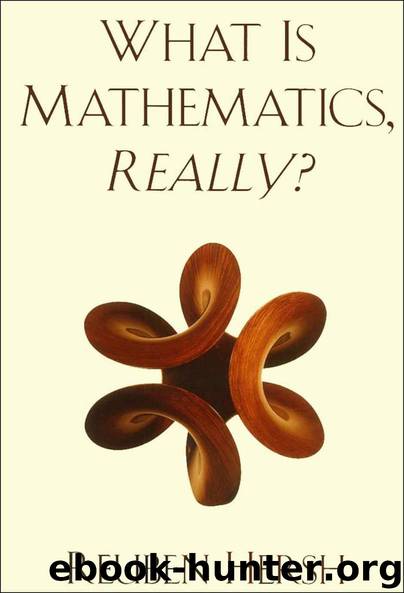What is Mathematics, Really? by Reuben Hersh

Author:Reuben Hersh
Language: eng
Format: mobi
Publisher: Oxford University Press
Published: 1997-08-21T00:00:00+00:00
That is, to prove by purely finite arguments that a contradiction, for example, 1 = 0, cannot be derived within the system.
In this way, mathematics would be given a guarantee of consistency. As a foundation this would have been weaker than one known to be true (as geometry was once believed to be true) or impossible to doubt (like, possibly, the laws of elementary logic.)
Hilbert’s formalism, like logicism, offered certainty and reliability for a price. The logicist would save mathematics by turning it into a tautology. The formalist would save it by turning it into a meaningless game. After mathematics is coded in a formal language and its proofs written in a way checkable by machine, the meaning of the symbols becomes extramathematical.
It’s very instructive that Hilbert’s writing and conversation displayed full conviction that mathematical problems are about real objects, and have answers that are true in the same sense that any statement about reality is true. He advocated a formalist interpretation of mathematics only as the price of obtaining certainty.
“The goal of my theory is to establish once and for all the certitude of mathematical methods. . . . The present state of affairs where we run up against the paradoxes is intolerable. Just think, the definitions and deductive methods which everyone learns, teaches and uses in mathematics, the paragon of truth and certitude, lead to absurdities! If mathematical thinking is defective, where are we to find truth and certitude?” (D. Hilbert, “On the Infinite,” in Philosophy of Mathematics by Benacerraf and Putnam).
As it happened, certainty could not be had, even at this price. A few years later, Kurt Gödel proved consistency could never be proved by the methods of proof Hilbert allowed. Gödel’s incompleteness theorems showed that Hilbert’s program was hopeless. Any formal system strong enough to contain arithmetic could never prove its own consistency. This theorem of Gödel’s is usually cited as the death blow to Hilbert’s program, and to formalism as a philosophy of mathematics.
(A simple new proof of Gödel’s theorem by George Boolos is given in the mathematical Notes and Comments.)
The search for secure foundations has never recovered from this defeat.
John von Neumann tells how “working mathematicians” responded to Brouwer, Hilbert, and Gödel:
1. “Only very few mathematicians were willing to accept the new, exigent standards for their own daily use. Very many, however, admitted that Weyl and Brouwer were prima facie right, but they themselves continued to trespass, that is, to do their own mathematics in the old, ‘easy’ fashion-probably in the hope that somebody else, at some other time, might find the answer to the intuitionistic critique and thereby justify them a posteriori.
2. “Hilbert came forward with the following ingenious idea to justify ‘classical’ (i.e., pre-intuitionist) mathematics: Even in the intuitionistic system it is possible to give a rigorous account of how classical mathematics operates, that is, one can describe how the classical system works, although one cannot justify its workings. It might therefore be possible to demonstrate intuitionistically that classical procedures can never lead into contradiction—into conflicts with each other.
Download
This site does not store any files on its server. We only index and link to content provided by other sites. Please contact the content providers to delete copyright contents if any and email us, we'll remove relevant links or contents immediately.
Periodization Training for Sports by Tudor Bompa(8170)
Why We Sleep: Unlocking the Power of Sleep and Dreams by Matthew Walker(6618)
Paper Towns by Green John(5089)
The Immortal Life of Henrietta Lacks by Rebecca Skloot(4525)
The Sports Rules Book by Human Kinetics(4292)
Dynamic Alignment Through Imagery by Eric Franklin(4116)
ACSM's Complete Guide to Fitness & Health by ACSM(3989)
Kaplan MCAT Organic Chemistry Review: Created for MCAT 2015 (Kaplan Test Prep) by Kaplan(3939)
Introduction to Kinesiology by Shirl J. Hoffman(3725)
Livewired by David Eagleman(3683)
The Death of the Heart by Elizabeth Bowen(3551)
The River of Consciousness by Oliver Sacks(3538)
Alchemy and Alchemists by C. J. S. Thompson(3449)
Bad Pharma by Ben Goldacre(3355)
Descartes' Error by Antonio Damasio(3230)
The Emperor of All Maladies: A Biography of Cancer by Siddhartha Mukherjee(3064)
The Gene: An Intimate History by Siddhartha Mukherjee(3047)
The Fate of Rome: Climate, Disease, and the End of an Empire (The Princeton History of the Ancient World) by Kyle Harper(3003)
Kaplan MCAT Behavioral Sciences Review: Created for MCAT 2015 (Kaplan Test Prep) by Kaplan(2936)
